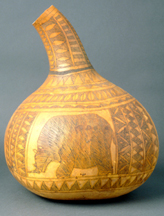AFRICAN AND TRIBAL
ARTS AND ARTIFACTS ON VIEW AT WILLIAM PATERSON UNIVERSITY
 A
selection of African art and artifacts, including sculpture, masks,
jewelry, dress, baskets and decorated gourds will be on view in
the Ben Shahn Galleries at William Paterson University in Wayne
from September 15 through October 17, 2003. Gallery hours are Monday
through Friday, 10 a.m. to 5 p.m. Admission is free. A
selection of African art and artifacts, including sculpture, masks,
jewelry, dress, baskets and decorated gourds will be on view in
the Ben Shahn Galleries at William Paterson University in Wayne
from September 15 through October 17, 2003. Gallery hours are Monday
through Friday, 10 a.m. to 5 p.m. Admission is free.
The exhibit, titled "Objects of Power," is a partial selection
from the nearly 700 objects donated to the University by Joan and
Gordon Tobias, private collectors who frequently traveled to Africa
and collected the pieces over a 30-year period.
The objects featured in the exhibit include ritual objects used
in initiation rites and passages, courtship and marriage ceremonies,
spirit and ancestor worship, and seasonal and harvest festivals.
"The visual arts and artifacts of Africa are wide-ranging and
touch every aspect of daily life," says Nancy Einreinhofer,
director of the Ben Shahn Galleries. "These objects are closely
tied to traditional African religious beliefs and the ceremonies
that are integral to African tribal communities."
Among the items on display is a nkisi nkondi, or nail figure, from
the Kongo people of Zaire. The torso of the three-foot wooden statue
is covered with nails. Magic statues such as this are believed to
have great power and are the property of the entire village. Villagers
might ask the statue to protect the village from evil, decide the
guilt or innocence of an accused criminal, settle a family argument
or end a drought or famine. The statue’s power is activated
by hammering a nail into the figure.
A carved wooden reliquary guardian figure, from the Kota people
of Gabon, is decorated with copper strips and plates. This type
of figure is placed on baskets containing the skulls and bones of
ancestors to protect them from evil forces.
A carved antelope headdress, crafted by the Bamana people in Mali,
is worn with a full body fiber costume representing water. The headdress
is strapped to the head during harvest festivals to beg the blessing
of the spirits for a good harvest.
Symbols of leadership, such as a ceremonial stool from the Akan
people of Ghana, are also on display. The stool, which represents
the unity of the state and the authority of the chief, is a pure
symbol. Not used for sitting, it is placed on a cushion to the right
of the chief when he holds court.
On exhibit for the first time is beadwork from the Ndebele tribe
northeast of Pretoria, South Africa, including intricate necklaces
worn by women. A variety of purses worn during courting rituals
by men from the Wodaabe, nomads from, central Niger and parts of
Nigeria and Cameroon, are also on display. Other items include various
animal skins and a selection of prints from paintings by Joy Adamson
from watercolors held in the collection of the National Museum in
Nairobi.
The exhibit is one of three concurrent shows in the Ben Shahn Galleries.
"Rocco Scary: Paper and Fire," on view in the East Gallery,
is a one-person exhibit featuring Scary’s artist’s books
constructed of handmade paper and steel. On view in the South Gallery
is a selection of drawings by the University’s faculty artists.
This exhibit is made possible in part by funds from the New Jersey
State Council on the Arts/Department of State, a partner agency
of the National Endowment for the Arts.
For additional information, please call the Ben Shahn Galleries
at William Paterson University, 973-720-2654.
#
# #
- For
Further Information, contact:
- Mary
Beth Zeman, Director, Public Relations 973-720-2966
8/25/03
|
|







